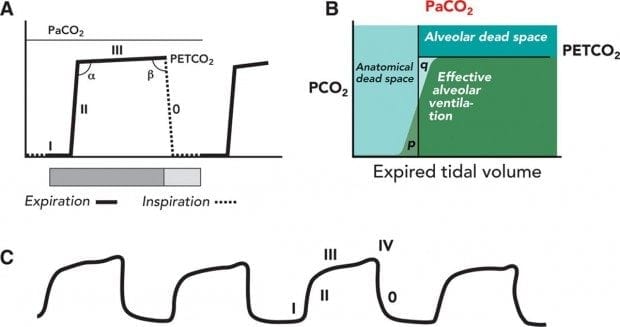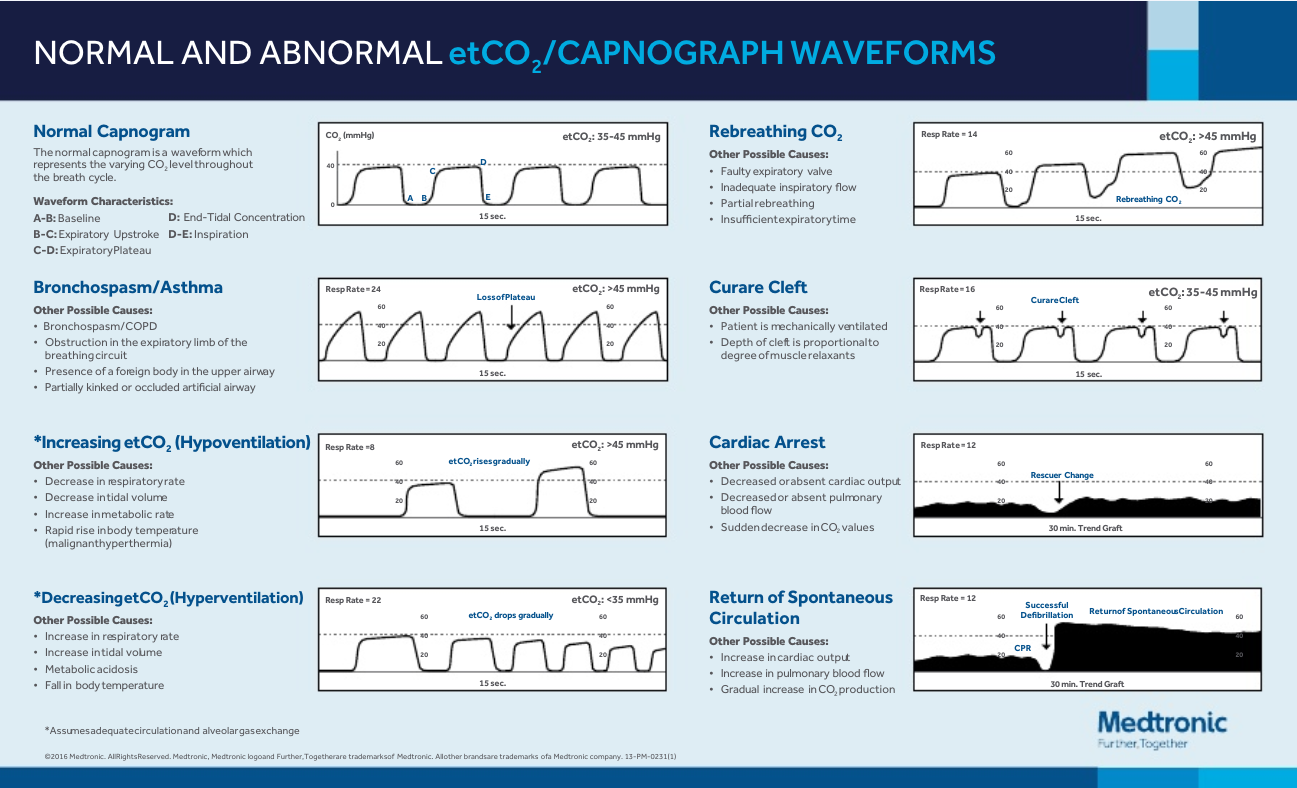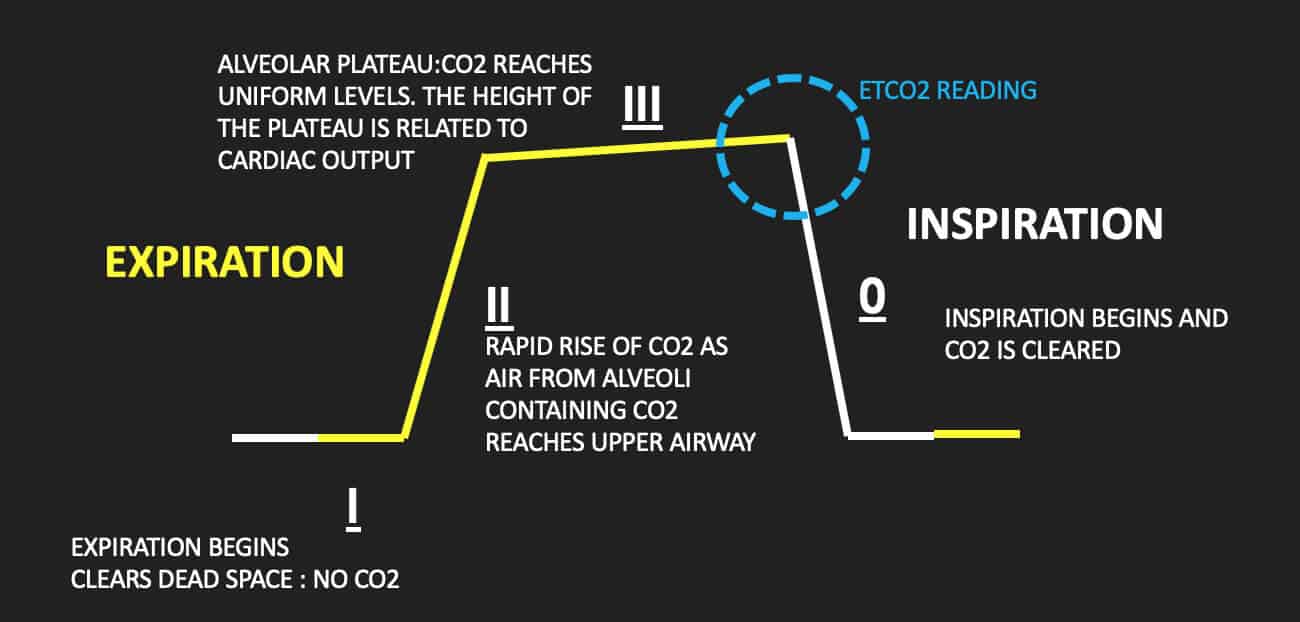end tidal co2 meaning
Capnogram the wave form. High ETCO2 helps predict respiratory arrest before a change in mentation and decompensation occur and time to prepare airway equipment.

The Impact Of Ventilation Rate On End Tidal Carbon Dioxide Level During Manual Cardiopulmonary Resuscitation Resuscitation
Carbon dioxide through the respiratory cycle Measuring of End tidal CO2 is considered a standard of care for confirming endotracheal tube placement An important adjunct for assessing a critical patient The Journey of A Molecule Through the Respiratory Cycle.

. This non-invasive monitor can give valuable information about cardiac output perfusion and ventilation. The normal end-tidal capnography wave form is basically a rounded rectangle. After 20 minutes of CPR death occurs if ETCO2 is consistently below 10 mmHg with 100 sensitivity and specificity 15.
The arterial CO2 value for normal breathing at rest is 40 mm. On this page we will look at the following two questions. What Increases End Tidal Co2.
End-tidal carbon dioxide monitoring is a noninvasive method of measuring exhaled carbon dioxide. What does high end tidal co2 mean. This is a major respiratory symptom.
Pulse oximetry assesses oxygenation which is the amount of oxygen that is bound to red blood cells. End tidal CO 2 EtCO 2 monitoring is the fastest indicator of ventilatory compromise. Mean of ETco2 and Hco3 levels in patients with metabolic acidosis were 2229 415 and.
End-tidal capnography is a measurement of carbon dioxide partial pressure measured in millimeters of mercury which is useful in assessing a patients ventilation. Types of End Tidal CO 2 Monitors. It consists of a number and a graph.
End-tidal CO 2 monitoring has also been useful for breathing retraining as it provides additional information about the progress of a persons breathing normalization. In the ED we typically think of a EtCO2 as a marker of perfusion and ventilation. Providers measure the value of ETCO2 in each exhaled breath with a very thin tube inserted into the breathing circuit or the patients oxygen mask or nasal prongs.
Think perfusion metabolic or psychological problem when ETCO2 is low. Other respiratory conditions can cause a low ETCO2 reading or hypocapnea. Studies have shown that in patients who had ETCO2 of 10 mmHg or less cardiac arrest was associated with death 13 14.
End-tidal carbon dioxide ETCO2 is the level of carbon dioxide that is released at the end of an exhaled breath. Capnography the measurement of carbon dioxide CO2 in exhaled breath. Monitoring end-tidal CO2 EtCO2 is a measure of metabolism ventilation and perfusion.
Capnography could be used to measure the end-tidal carbon dioxide ETCO2 levels and ETco2 has a close correlation with the PaCo2. Monitoring of end-tidal carbon dioxide EtCO2 is a noninvasive method that measures the partial pressure or maximal concentration of carbon dioxide CO2 at the end of exhaled breath which is expressed as a percentage of CO2. It is the measurement of CO2 at the completion of exhalation and roughly correlates to the CO2 present in arterial blood.
End tidal carbon dioxide concentration MONITORING of end-tidal carbon dioxide is one of the most important means of determining the physiologic well-being of anesthetized patients. Waveform capnography represents the amount of carbon dioxide CO2 in exhaled air which assesses ventilation. End Tidal CO ETCO is the amount of carbon dioxide released by an exhaled breath at the end of an exhaled breath and it indicates whether the patient is breathing through a ventilator.
The number is capnometry which is the partial pressure of CO2 detected at the end of exhalation. The aim of this study was comparison the ETco2 and arterial blood bicarbonate levels in patients with metabolic acidosis. Oxygenation Versus Ventilation Oxygenation is how we get oxygen to the tissue.
ETCO2 is a reliable indicator with a high prognostic value in determining the CPR outcome 11 12. Capnometer the numeric measurement of CO2. The normal values are 5 to 6 CO2 which is equivalent to 35-45 mmHg.
End-tidal carbon dioxide monitoring ETCO2 has clinical uses far beyond solely determining hypo- or hyperventilation. In normal conditions CO2 is 5 to 6 which is equivalent to 35-45 mmHg. The amount of CO2 at the end of exhalation or end-tidal CO2 ETCO2 is normally 35-45 mm HG.
Whilst capnography assesses ventilation which is the movement of air in and out of the lungs. An end-tidal capnography waveform is a simple graphic measurement of how much CO 2 a person is exhaling. END TIDAL CO2 Has Many Uses What Is ETCO2.
The height of the capnography waveform accompanies this number on the monitor as well as the. However EtCO2 is an extremely powerful surrogate for endotracheal tube ETT P osition CPR Q uality R eturn of spontaneous. Monitoring of end-tidal carbon dioxide EtCO2 is a noninvasive method that measures the partial pressure or maximal concentration of carbon dioxide CO2 at the end of exhaled breath which is expressed as a percentage of CO2.
Most medical sources define hypocapnia as less than 35 mm Hg for partial CO2 pressure in the arterial blood. End-Tidal CO2 in Cardiopulmonary Resuscitation. Sometimes however etCO 2 monitoring is used as a feedback or biofeedback mechanism.
Watch what causes low end tidal co2 Video. End-tidal capnography or end-tidal CO2 EtCO2 monitoring is a non-invasive technique that measures the partial pressure or maximal concentration of carbon dioxide CO2 at the end of an exhaled breath. Definition of Low CO2 hypocapnia Hypocapnia hypocapnea also known as hypocarbia is defined as a deficiency of carbon dioxide in the arterial blood.
Capnography refers to the process of measuring the partial pressure of end-tidal CO2 in each expired breath. End-tidal CO2 EtCO2 monitoring is a noninvasive technique which measures the partial pressure or maximal concentration of carbon dioxide CO2 at the end of an exhaled breath which is expressed as a percentage of CO2 or mmHg. This is end-tidal CO2 ETCO2 which is normally 35-45 mm Hg.
In normal conditions CO2 is 5 to 6 which is equivalent to 35-45 mmHg. This technique is often used in patients who are not intubated although it is commonly used in intubated patients receiving mechanical ventilation. What Does Etco2 Determine.
End-tidal CO2 EtCO2 monitoring is a measure of metabolism perfusion and ventilation. ETCO2 levels reflect the adequacy with which carbon dioxide CO2 is carried in the blood back to the lungs and exhaled. Normal end-tidal capnography is.
Exhaled carbon dioxide both in terms of its quantity and pattern provides detailed information on the cardiopulmonary system. End Tidal CO2 ETCO2 or PetCO2 - the level of partial pressure of carbon dioxide released at end of expiration.

Basic Capnography Interpretation Nuem Blog

Waveform Capnography In The Intubated Patient Emcrit Project

Waveform Capnography In The Intubated Patient Emcrit Project

Capnography Waveform Interpretation Litfl Ccc Equipment
End Tidal Co2 The Drummer Of The Vital Sign Band Pem4
Emdocs Net Emergency Medicine Educationcapnography In The Ed Emdocs Net Emergency Medicine Education

Basic Capnography Interpretation Nuem Blog
5 Medical Conditions Where Capnography Can Affect Bls Care Capnoacademy Capnoacademy

Capnography Provides Bigger Physiological Picture To Maximize Patient Care Jems Ems Emergency Medical Services Training Paramedic Emt News
Riding The Wave Of Capnography Understanding Etco2 Vetbloom Blog

E Learning Basics Of Capnography Youtube

Etco2 Valuable Vital Sign To Assess Perfusion The Airway Jedi

Waveform Capnography In The Intubated Patient Emcrit Project

Normal And Abnormal Capnography Waveforms Infographic Capnoacademy Capnoacademy
The Normal Capnograph Waveform Deranged Physiology

Waveform Capnography In The Intubated Patient Emcrit Project


